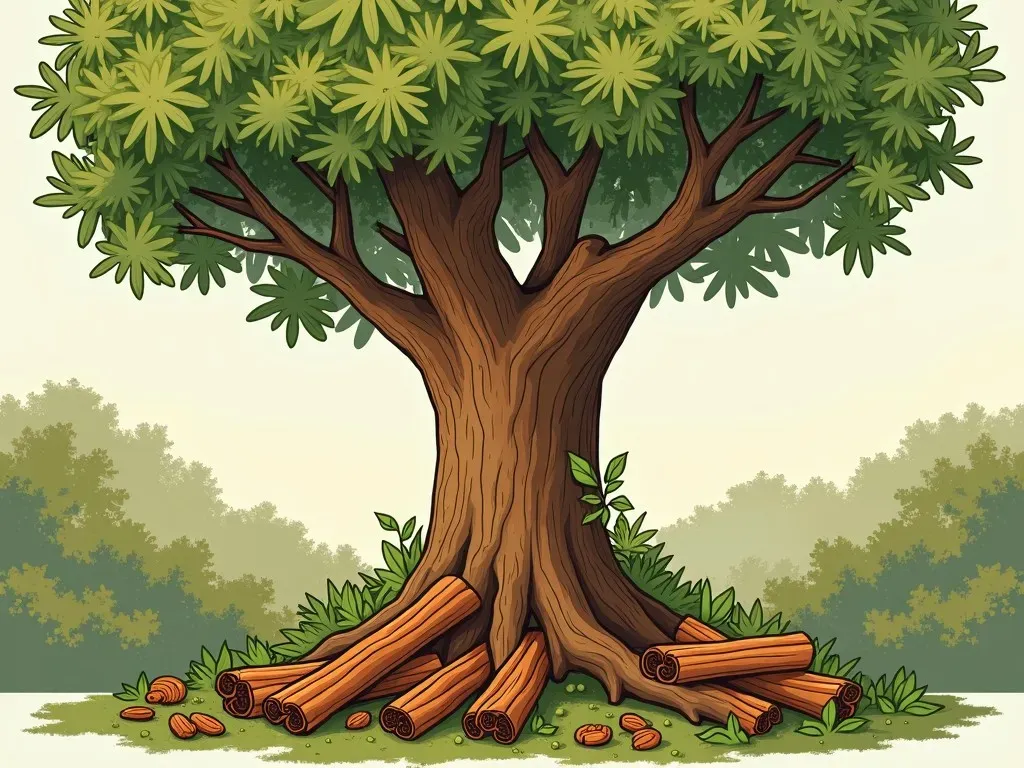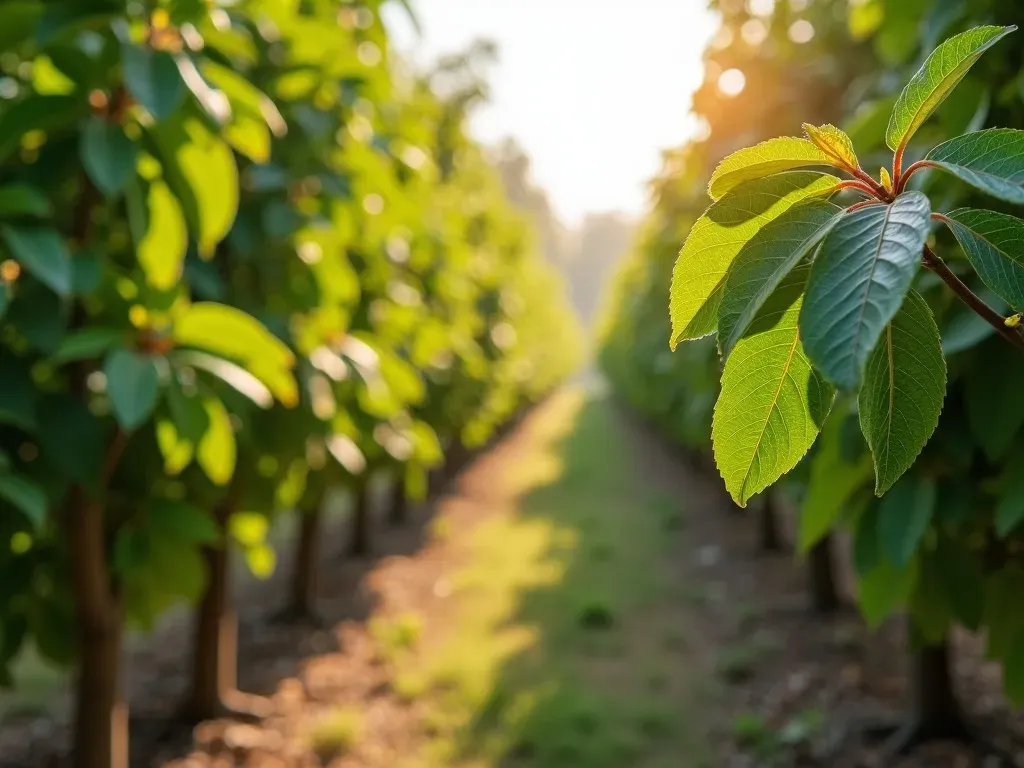The cinnamon tree, scientifically known as Cinnamomum verum, is a small evergreen tree revered for its aromatic bark—widely used as a beloved spice. Native to Sri Lanka, this tree belongs to the Lauraceae family and is often referred to as the “true cinnamon tree” or “Ceylon cinnamon tree.” The inner bark of this tree is where the cherished cinnamon spice derives its flavor and fragrant qualities.
Description and Characteristics of Cinnamon Trees
Cinnamon trees typically grow to about 10 to 15 meters (33 to 49 feet) in height in their native habitats. However, when cultivated, they are often pruned to remain at a more manageable size. The tree features dark green, glossy leaves that are around 7-18 centimeters (3-7 inches) in length. The flowers are small and tend to grow in clusters, leading to berry-like fruits.
Physical Appearance
| Feature | Description |
|---|---|
| Height | 10-15 meters (33-49 feet) |
| Leaves | Dark green, glossy, 7-18 cm (3-7 in) |
| Flowers | Small clusters, yellow or green |
| Fruit | Berry-like, green when unripe, turns darker when mature |

Growing Conditions for Cinnamon Trees
The cinnamon tree thrives in warm, humid climates and prefers well-drained soil rich in organic matter. When considering the optimal conditions for planting and growing a cinnamon tree, keep in mind the following factors:
Climate
- Temperature: Cinnamon requires tropical or subtropical climates, ideally thriving in temperatures between 20°C to 30°C (68°F to 86°F).
- Humidity: High humidity levels are essential for healthy growth; ideally 60% to 70%.
- Sunlight: Full sun exposure is optimal, but partial shade in extremely hot regions can prevent leaf scorch.
Soil
- Type: Loamy, well-draining soil with high organic content promotes healthy growth.
- pH: Slightly acidic to neutral (pH 5.5 to 7.0) is preferred to ensure nutrient availability.
Watering
- The cinnamon tree requires consistent moisture, especially during the growing season. Regular watering is necessary, particularly during dry spells, but caution is advised to avoid waterlogged conditions.
Table: Ideal Growing Conditions for Cinnamon Trees
| Condition | Ideal Requirements |
|---|---|
| Temperature | 20°C to 30°C (68°F to 86°F) |
| Humidity | 60% to 70% |
| Soil Type | Loamy, well-draining |
| pH | 5.5 to 7.0 |
| Watering | Regular, consistent moisture |

Reference Video
Cultivation and Harvesting of Cinnamon Trees
Cinnamon trees can be grown from seeds, cuttings, or layering techniques. Opting for cuttings is the most common practice, as it allows for faster growth and more vigorous trees.
Harvesting
After approximately two to three years of growth, the bark of the cinnamon tree can be harvested. The primary harvest season generally occurs after the rainy season.
- Cutting the Stems: Select stems that are 1 to 2 years old. Each stem should be cut down to around 30 cm (12 inches) above the ground.
- Bark Removal: The outer bark is stripped away to expose the inner bark, which is then carefully removed in rolls.
- Drying: The harvested inner bark is left to dry in a shaded area to enhance its flavor and aroma.
Table: Cinnamon Harvesting Process
| Step | Description |
|---|---|
| Cutting Stems | Cut 1-2 year-old stems to 30 cm height |
| Bark Removal | Strip outer bark to expose inner bark |
| Drying | Dry in shaded area |

Culinary and Medicinal Uses of Cinnamon
Cinnamon is an incredibly versatile spice with a wide array of culinary and medicinal applications. Here are a few notable uses:
Culinary Uses
- Flavoring Agent: Cinnamon adds warmth to sweet and savory dishes, making it popular in desserts, curries, and beverages.
- Baking Ingredient: It’s often used in recipes for cakes, cookies, and pastries.
Medicinal Uses
- Antioxidant Properties: Cinnamon is rich in antioxidants, helping to combat oxidative stress in the body.
- Anti-Inflammatory: The spice has natural anti-inflammatory effects, which can aid in reducing bodily inflammation.
- Blood Sugar Regulation: Studies suggest that cinnamon can help lower blood sugar levels, making it a beneficial addition for people with diabetes.
Common FAQs on the Cinnamon Tree
What does a cinnamon tree look like?
The cinnamon tree is characterized by its tall stature, glossy green leaves, and small clusters of flowers. The inner bark, when harvested, rolls up into quills that become the familiar cinnamon sticks.

How do I propagate a cinnamon tree?
Cinnamon trees can be propagated through several methods, including seeds, stem cuttings, or layering. Among these, using stem cuttings is the most efficient method.
Where can I grow a cinnamon tree?
Cinnamon trees should be planted in warm, humid climates. They are ideal for tropical regions, especially in Sri Lanka and parts of Southeast Asia.
Is true cinnamon different from cassia cinnamon?
Yes, true cinnamon, known as Ceylon cinnamon, comes from the Cinnamomum verum tree and is considered superior due to its lower coumarin content and more delicate flavor, while cassia cinnamon is derived from Cinnamomum cassia and is more commonly found in stores.
How can I care for my cinnamon tree at home?
To care for a cinnamon tree, provide well-draining soil, a warm and humid environment, and consistent watering. Pruning may be necessary to maintain size and promote healthy growth.
For further information, you can refer to this link for an authoritative overview of cinnamon trees.

Through understanding the unique characteristics, cultivation processes, and diverse uses of the cinnamon tree, one can appreciate this remarkable plant not only for its economic and culinary benefits but also for its role in traditional medicine and culture.
